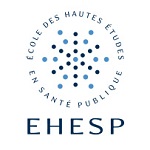Associations of prenatal exposure to outdoor PM2.5 and NO2 with childhood respiratory symptoms [presented at an ISEE annual meeting]
Abstract
Background and aim:
Prenatal and early life exposures to air pollution have been shown to play an important role in the development of childhood respiratory and allergic diseases. Nitrogen dioxide (NO2) has been associated with increased paediatric asthma incidence, while prenatal exposure to fine particulate matter (PM2.5) has chronic and adverse effects in lung development and respiratory health. The aim of the study was to assess the associations of prenatal exposure to air pollutants with the prevalence of respiratory symptoms, asthma, allergic rhinitis, and eczema in children.
Methods:
We selected 2150 children from the PELAGIE Cohort in Brittany, France, that were followed-up at 2, 6 and 12 years old. Parents reported children's respiratory health history, family lifestyle behaviours and children’s immediate environment through standardized and validated questionnaires. Concentrations of PM2.5 and NO2 were modelled during the pregnancy at residential address. We used logistic regression models to assess the associations per one increase of an interquartile range (IQR), adjusted by sex, parents smoking during pregnancy, environmental tobacco smoke of children and children smoking (at 12). Results Prenatal concentrations of NO2 were 20.04±6.33μg/m3 (IQR=2.48) and PM2.5 10.24 ;1.17 g/m3 (IQR=1.59). Prenatal exposure to higher NO2 concentrations was associated with increased odds of wheezing episodes at the age of 2 years [odds ratio (OR) = 1.26; 95% confidence interval (CI):1.00–2.61] and higher odds of suffering asthma at 12 years old [OR=1.33; 95%CI: 0.97–1.82]. Overall, higher exposure to NO2 and PM2.5 during the prenatal period showed associations with increased odds of sneezing, wheezing and asthma attacks during childhood; however, these associations were at the limit of statistical significance.
Conclusion:
Prenatal exposures to ambient PM2.5 and NO2 seem associated with higher risk of respiratory and allergic diseases in children even at relatively low levels of air pollution concentrations.
